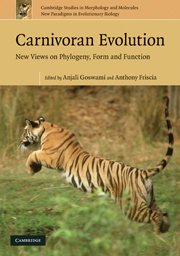Book contents
- Frontmatter
- Contents
- Contributors
- Preface
- Acknowledgements
- 1 Introduction to Carnivora
- 2 Phylogeny of the Carnivora and Carnivoramorpha, and the use of the fossil record to enhance understanding of evolutionary transformations
- 3 Phylogeny of the Viverridae and ‘Viverrid-like’ feliforms
- 4 Molecular and morphological evidence for Ailuridae and a review of its genera
- 5 The influence of character correlations on phylogenetic analyses: a case study of the carnivoran cranium
- 6 What's the difference? A multiphasic allometric analysis of fossil and living lions
- 7 Evolution in Carnivora: identifying a morphological bias
- 8 The biogeography of carnivore ecomorphology
- 9 Comparative ecomorphology and biogeography of Herpestidae and Viverridae (Carnivora) in Africa and Asia
- 10 Ecomorphological analysis of carnivore guilds in the Eocene through Miocene of Laurasia
- 11 Ecomorphology of North American Eocene carnivores: evidence for competition between Carnivorans and Creodonts
- 12 Morphometric analysis of cranial morphology in pinnipeds (Mammalia, Carnivora): convergence, ecology, ontogeny, and dimorphism
- 13 Tiptoeing through the trophics: geographic variation in carnivoran locomotor ecomorphology in relation to environment
- 14 Interpreting sabretooth cat (Carnivora; Felidae; Machairodontinae) postcranial morphology in light of scaling patterns in felids
- 15 Cranial mechanics of mammalian carnivores: recent advances using a finite element approach
- Index
- Plates
- References
5 - The influence of character correlations on phylogenetic analyses: a case study of the carnivoran cranium
Published online by Cambridge University Press: 05 July 2014
- Frontmatter
- Contents
- Contributors
- Preface
- Acknowledgements
- 1 Introduction to Carnivora
- 2 Phylogeny of the Carnivora and Carnivoramorpha, and the use of the fossil record to enhance understanding of evolutionary transformations
- 3 Phylogeny of the Viverridae and ‘Viverrid-like’ feliforms
- 4 Molecular and morphological evidence for Ailuridae and a review of its genera
- 5 The influence of character correlations on phylogenetic analyses: a case study of the carnivoran cranium
- 6 What's the difference? A multiphasic allometric analysis of fossil and living lions
- 7 Evolution in Carnivora: identifying a morphological bias
- 8 The biogeography of carnivore ecomorphology
- 9 Comparative ecomorphology and biogeography of Herpestidae and Viverridae (Carnivora) in Africa and Asia
- 10 Ecomorphological analysis of carnivore guilds in the Eocene through Miocene of Laurasia
- 11 Ecomorphology of North American Eocene carnivores: evidence for competition between Carnivorans and Creodonts
- 12 Morphometric analysis of cranial morphology in pinnipeds (Mammalia, Carnivora): convergence, ecology, ontogeny, and dimorphism
- 13 Tiptoeing through the trophics: geographic variation in carnivoran locomotor ecomorphology in relation to environment
- 14 Interpreting sabretooth cat (Carnivora; Felidae; Machairodontinae) postcranial morphology in light of scaling patterns in felids
- 15 Cranial mechanics of mammalian carnivores: recent advances using a finite element approach
- Index
- Plates
- References
Summary
Introduction
Character independence is a major assumption in many morphology-based phylogenetic analyses (Felsenstein, 1973; Emerson and Hastings, 1998). However, the fact that most studies of modularity and morphological integration have found significant correlations among many phenotypic traits worryingly calls into question the validity of this assumption. Because gathering data on character correlations for every character in every taxon of interest is unrealistic, studies of modularity are more tractable for assessing the impact of character non-independence on phylogenetic analyses in a real system because modules summarise broad patterns of trait correlations. In this study, we use empirically derived data on cranial modularity and morphological integration in the carnivoran skull to assess the impact of trait correlations on phylogenetic analyses of Carnivora.
Carnivorans are a speciose clade of over 270 living species, with an extremely broad range of morphological and dietary diversity, from social insectivores to folivores to hypercarnivores (Nowak, 1999; Myers, 2000). This diversity offers many opportunities to isolate various potential influences on morphology, and, in this case, to study the effects of trait correlations on cranial morphology. Carnivorans also have an excellent fossil record, providing the opportunity to examine morphologies not represented in extant species, such as in the sabre-toothed cat Smilodon. Perhaps most importantly, several recent molecular and morphological studies of carnivoran phylogeny (Hunt and Tedford, 1993; Wyss and Flynn, 1993; Tedford et al., 1995; Flynn and Nedbal, 1998; Flynn et al., 2000, 2005; Flynn and Wesley-Hunt, 2005; Wesley-Hunt and Flynn, 2005; Flynn et al., this volume) provide the necessary resolution to assess the influence of character correlations on morphology-based phylogenetic analyses.
- Type
- Chapter
- Information
- Carnivoran EvolutionNew Views on Phylogeny, Form and Function, pp. 141 - 164Publisher: Cambridge University PressPrint publication year: 2010
References
- 20
- Cited by

